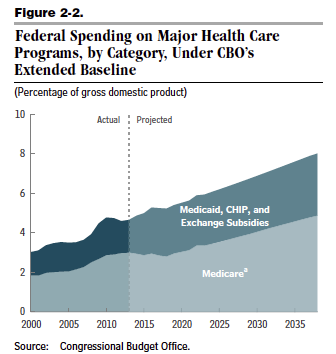 |
| (All charts are from Trends in Healthcare Cost Growth and the Role of the ACA)
I've been waiting for the White House Council of Economic Advisors to put out a solid report highlighting the slowdown in healthcare cost growth due to the ACA, and here it is! Terrific stuff, which, over the long term, will define the success ot failure of the ACA much more than website disasters or even the middle class policy cancellations: Are healthcare costs slowing and is the ACA playing a role in the slowdown? According to the CEA's report (enclosed charts) the answer to both questions is a strong Yes!
Up until this Spring (May, 2013), most analysts were saying the slowdown was due to the Recession, with not much influence from the ACA. Beginning in May, a number of studies, including one by the CBO in August, made the other argument that the ACA is largely responsible for the slowdown, partly because the most dramatic slowdown was and is occurring in the public programs (Medicare, Medicaid) where health spending, funded by the Government, is not affected by recession-induced income drops. The chart above shows that real per capita Medicare spending has been flat and has actually declined for Medicaid. (Remember: this measure takes nominal cost growth, adjusts for population changes, then strips out inflation.)
Here are the detailed numbers:
The slowdown is occurring across the board - in all payer groups and in all categories of spending. Here's a look at the NHE real per capita trends over a longer period. Clearly what we are seeing is new:
The above is based on spending, which includes, price and utilization. Here's a look at price alone, comparing healthcare price growth to the general economy. Price inflation is near historical lows, plus it is running at the same rate as the general economy - very unusual and extremely encouraging.
So how could the ACA be influencing this slowdown in cost inflation? The bill in many ways, and in many places is telling the healthcare industry the following: "Time to move away from fee-for-service. In the future, we (the Government) will reward quality, not quantity of patient care. We will not just focus on screwing down prices; rather we will experiment with a large and expandable array of test protocols, where we will be especially interested in forms of care coordination and patient management that reduce system utilization and complexity. We will figure out ways for you providers to be compensated for successfully keeping patients out of the system - in other words, you will be rewarded for preventing sickness, as opposed to just treating it when it shows up. We will begin to measure quality, which will then be rewarded. As part of this overall move towards rewarding quality, not quantity of medical service, we expect everyone to get on the same informational page by using Electronic Medical Records. In the future, the most successful and profitable providers will be those who keep their patients the healthiest."
Here's a specific example of a quality improvement program that was targeted in the bill - reducing hospital readmissions. Initial results look good.
|
The bump in 2015/2016 is the ACA rollout, after which the line dips down for two years, then it heads back up ,beginning in 2018. Why? The CBO does not yet believe the cost slowdown is an enduring structural change. Take a look at this graph from the most recent Long Term Budget Outlook:
The Medicare/Medicaid lines keep going up at a steady rate, because CBO uses historical "excess cost growth" trends to make forward forecasts. But I think this is going to change: the above graph was part of the Long Term Budget Outlook published in September. In August, one of the CBO's own economists, Michael Levine (along with Melinda Buntin of Vanderbilt) published a strong paper titled "Why has Growth in Spending for Fee-for-Service Medicaid Slowed?", concluding that it was "provider and patient behavior" changes that probably explain the slowdown, not the Recession. As more of this kind of analysis is done, including the CEA report we've been reviewing, these forward forecasts will come down. Here's a chart I just put together to demonstrate at a granular level how Medicare/Medicaid expenses have flattened out:
Medicare/Medicaid are not growing as a percent of GDP. Because this trend has not been proved out yet, the CBO reverts to historical "excess cost growth" forecasts, beginning in 2018. As a result, beginning at the end of this decade, we appear to have a deficit and debt level problem THAT I DO NOT BELIEVE WE WILL HAVE. Medicare/Medicaid move up to over 8.0% of GDP giving us an ongoing deficit/debt problem. I DO NOT THINK THIS PROBLEM IS REAL!
This is the really BIG story. The ACA has bent the cost curve. Our long term deficit/debt problem is solved. We don't have to carve up Medicare, or reduce benefits for Social Security. Our country is on solid financial footing, as long as we continue the progress the ACA has initiated. As savings versus original projections keep coming in, we should invest these back into building infrastructure, and growing the economy.
This is the story that needs to be told to firm up support for the ACA.







No comments:
Post a Comment